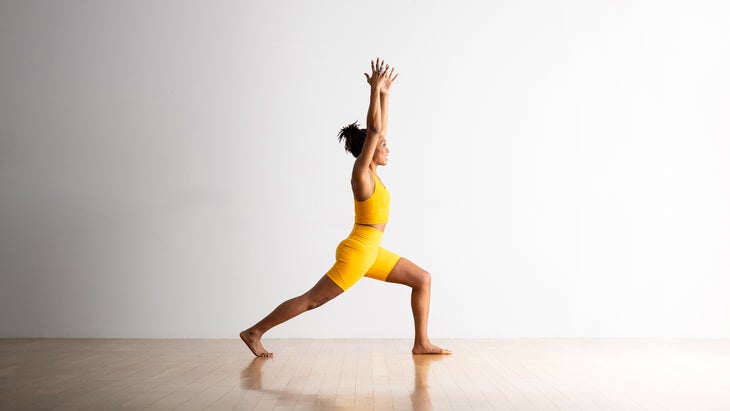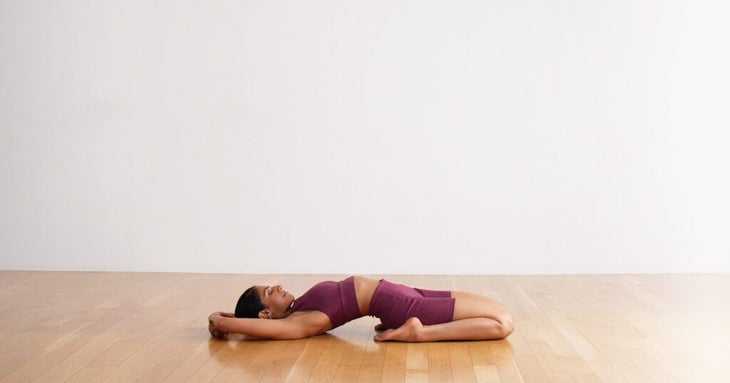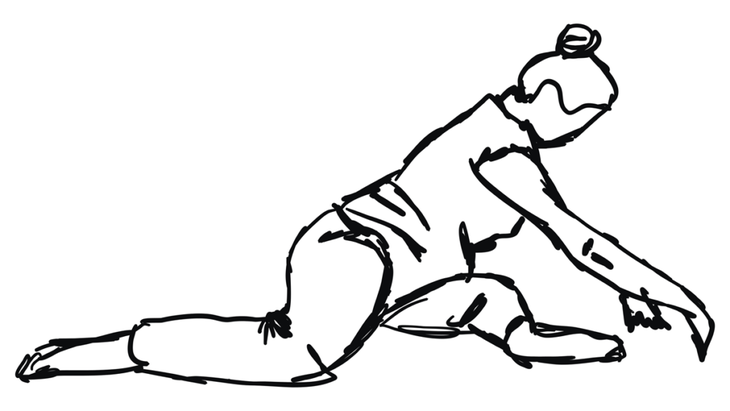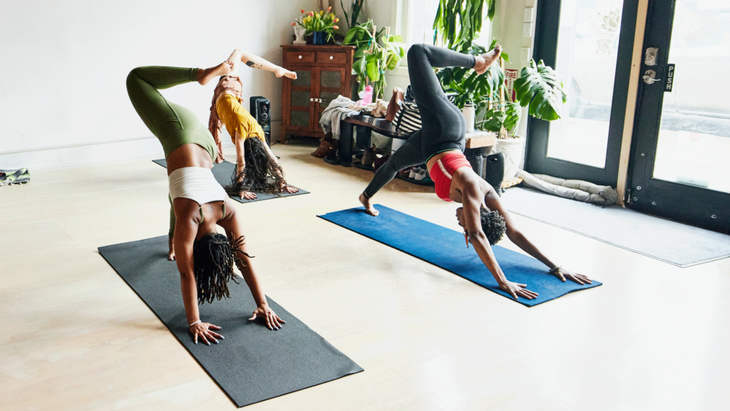
“], “filter”: { “nextExceptions”: “img, blockquote, div”, “nextContainsExceptions”: “img, blockquote, a.btn, a.o-button”} }”>
Heading out the door? Read this article on the new Outside+ app available now on iOS devices for members!
>”,”name”:”in-content-cta”,”type”:”link”}}”>Download the app.
Ask most yoga students what they want to practice during class and chances are they’ll tell you hip openers. As with anything we feel overly enthusiastic about, the human tendency is to equate bigger and more dramatic with better. (Yes, we’re also talking about Stanley cups.) But that’s not accurate when it comes to most of our yoga practice, including hip flexor stretches.
The Anatomy of Hip Flexor Stretches
When we continue the “fetishization” of hip openers, as New Zealand-based yoga teacher and Yoga Medicine podcast co-host Rachel Land refers to them, we overlook other, more subtle, aspects of hip opening. The hip flexors comprise several muscles, including the psoas major and minor, rectus femoris, iliacus, iliocapsularis, and sartorius. Each of these muscles and related tendons cross the front of the hip joint. When they contract, they draw your chest and legs closer to one another. Stretching these muscles means lengthening the muscle, and that’s achieved by taking it in the opposite direction.
Each hip flexor stretch you practice is going to land a little differently for each of those muscles. The more different poses you practice, the more likely you’ll experience significant change in your flexibility.
Land and others who have spent years studying, practicing, and teaching an array of hip flexor stretches consider some of the less theatric hip flexor stretches to be the ones they most appreciate. And when we recently inquired which they consider the most beneficial, many couldn’t contain their hip flexor favoritism to any single pose and shared several less common yet essential poses.
As you try to shift your approach to hip opening, consider that no single component of your yoga practice will instantaneously make your life better. “If your backbends are getting deeper and your hip opening more dramatic, yet you still have the same arguments with your partner or simply aren’t that nice to the people you encounter, then you need to readdress the way you engage with your yoga practice,” explains London-based teacher Adam Husler in a recent Instagram post. “The asana (physical pose) is a vehicle for self inquiry…with the side benefit of getting more bendy and strong.”
Following are some areas of inquiry for you to explore.
7 Best Hip Flexor Stretches, According to Yoga Teachers
Some of the following hip flexor stretches will be familiar. Others less so. You’ll quickly notice which ones feel like they’re exactly what you’ve been lacking in your life but didn’t know it.

1. High Lunge or Crescent Lunge
“Most teachers refer to shapes that invite external hip rotation “hip openers,” but my go-to hip openers encourage gentle length along the front line of the body,” explains Phoenix-based yoga teacher Kimberlee Morrison. She practices High Lunge or Crescent Lunge as “an excellent counter movement for the sitting I do during the day.”
Although teachers used to cue students to bend the front knee until the thigh is parallel to the mat, what’s most important is that you simply feel a stretch without allowing it to become so intense that you to hold your breath. Morrison adds “a reach up and over with the arm opposite the bent knee” to bring another dimension to the stretch. You can feel the difference.
2. Seated Side Twist
Another hip flexor stretch Morrison relies on is what she calls Pinwheel Twist and it’s essentially a moment frozen in time during Windshield Wipers. You’re sitting on the mat, your knees are bent, your feet are on the floor wider than your hips, and your knees go in one direction as your gaze goes the other way.
She appreciates its multitasking ability to stretch not only the hip flexors but also the quadriceps, and the outer hip and glutes. “This one is also a little gentler on the low spine than most twists that focus on spinal rotation, since the rotation here is mostly in the hips, as the pelvis stays relatively level,” explains Morrison.

3. Dancer Pose (Natarajasana)
“People may fight me on considering this a hip opener, but I have to say Dancer Pose, or Standing Bow Pulling Pose as we call it from my lineage,” says yoga teacher Kate Herrera Jenkins, founder of Native Strength Revolution and member of the Pueblo of Cochiti in New Mexico.
Although many students find the pose to be an intimidating balancing pose, Herrera Jenkins found it to be an elegant recovery stretch. “I suffered a super painful, torn labrum from a trail run fall in August. My injury caused pain to simply stand upright,” she explains.

Her approach to coming into Dancer works well for anyone unfamiliar with the balancing pose. Her first step was being able to simply stand Tadasana (Mountain Pose) and slowly regain the stability of the hip flexor and hip joint. Her next focus was on being able to bend her knee and, not long after, grab her foot behind her in the hip flexor stretch runners commonly practice. From there, she was able to press her foot into her hand and bring her upper body forward and down for a beautiful stretch along the hip flexors. You can practice this near a chair or alongside a wall so that the arm opposite your bent knee can reach out for support.

4. Half Saddle Pose (Ardha Supta Virasana)
“We focus so much on outer and inner hip openers and hamstring stretches that we sometimes forget how influential quad and hip mobility can be on not just our hips but low back, too,” says Land.
She favors Half Saddle Pose (Ardha Supta Virasana). The “half” in the name refers to bending just one leg at a time, rather than the traditional ask to bend both. Unlike in the photo above, you can extend the other leg straight in front of you or bend the knee and place the foot flat on the mat. Land also practices it with the support of a bolster beneath her back.
Once you find the position, there’s a subtle but essential movement in this pose that’s often overlooked. Land suggests you “lengthen your spine,” as teachers say. That essentially means reach your sacrum toward your knees, which enhances the stretch in the hip flexors and minimizes compression in the lumbar region. She notes that some people are more comfortable with padding, like a folded blanket, under the front of their ankle.
5. Lazy Lizard or Half Frog
“I love love love a yin pose that I personally call the Lazy Lizard,” says Leta LaVigne, yoga teacher and founder of yogaROCKS studios in Finland. “Maybe it’s a species of Half Frog?” LaVigne explains that the pose begins with lying on your stomach. Bend one knee and take that leg out to the side at approximately a right angle from your body, with a bend in your knee creating another right angle. Feeling for the stretch along the inner thigh. If you don’t feel a stretch, try elevating the knee and shin on a folded blanket, bolster, block, book, you get the idea. You can either rest your upper body on the floor or prop yourself up on your elbows or a bolster.
“There’s just something really calming about lying prone and being invited to release your entirety into contact with the earth,” says LaVigne. “It’s like a big sigh for your body.”

6. Deer Pose or 90/90
More than one teacher mentioned their affinity for the stretch that’s known in yin yoga as Deer Pose and moonlights as the exercise known as 90/90. The name “90/90” comes from the fact that you’re trying to create two right angles with your legs and the shape is essentially a seated cousin to Lazy Lizard Pose.
“I love this one because it also lengthens the internal rotators on my back leg, which are notoriously tight from long hours of sitting while I write,” says yoga teacher and author Sarah Ezrin. “I notice a huge difference in my strides or gait and breathing when I do this consistently.”
The name is perhaps the simplest cue for coming into the pose. You basically come to a seated position, shift your weight onto one hip, and then bend both knees approximately 90 degrees, while noting what works best for your body and adjusting accordingly. The thigh of one leg will be approximately parallel to the shin of your other leg. You can remain upright, start to lean forward, bending at the hips, or lean yourself backward and perhaps come onto your forearms, depending on which stretch you prefer.

7. Scorpion Stretch
Several yoga teachers expressed a tendency to linger in a pose that’s not exactly a pose but may as well be for all the relief it brings. It’s the moments you linger in between Three-Legged Dog in which you extend one straight behind you, bend your knee, and let it fall open behind you in a blissful state of being unconstrained.
There’s a reason you typically see students stay in the stretch for several beats even after the teacher cues the next pose. The stretch reminds us of the truth in the quote from French composer Claude Debussy in which he expressed, “Music is the space between the notes.” Let’s not become so preoccupied with the specific notes that we overlook our unique beat.






